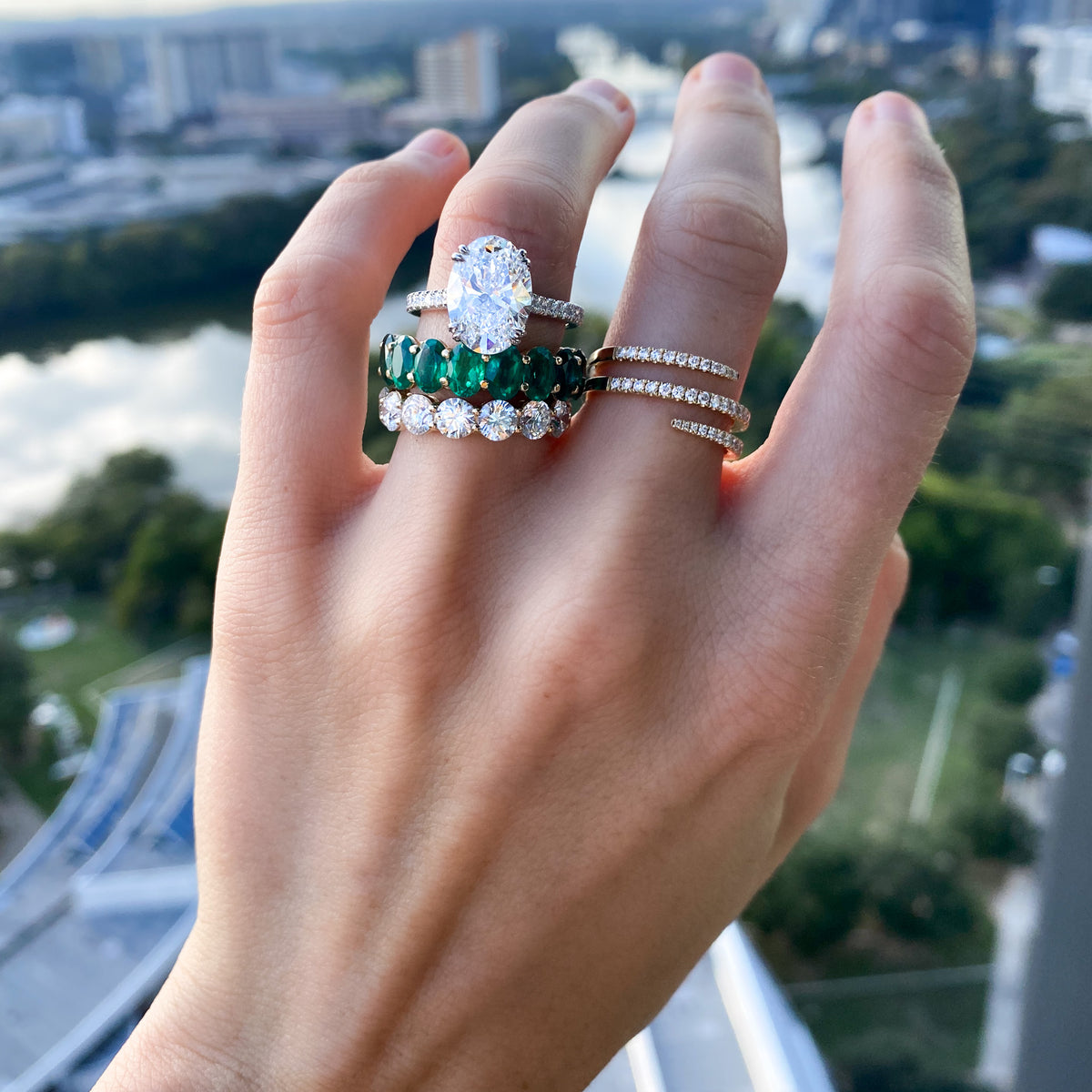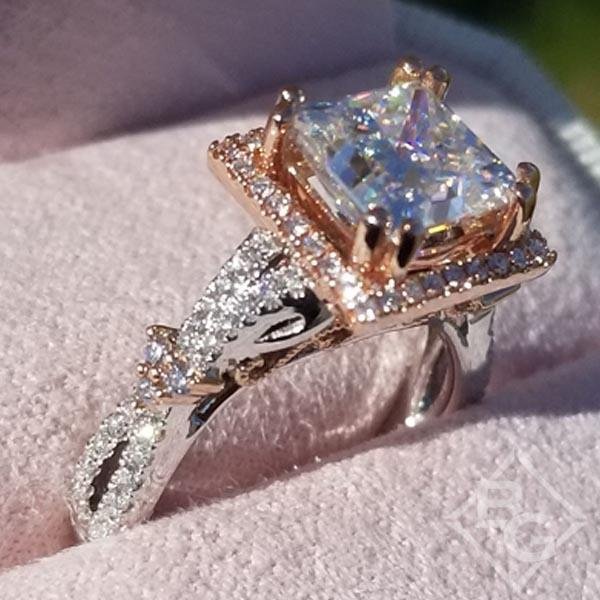Why More Couples in Diswilmar Are Choosing lab grown diamond engagement rings
Wiki Article
Why Laboratory Grown Diamond Involvement Rings Are the Perfect Selection for Eco-Conscious Couples
Lab-grown Diamond involvement rings present a compelling choice for pairs who focus on sustainability. These rubies offer a striking alternative to standard mined stones, considerably minimizing ecological damage. They are created using innovative methods that ensure both high quality and radiance. As understanding of honest sourcing expands, many couples are reconsidering their selections. What effects does this change have for the future of the Diamond market?

The Environmental Influence of Standard Diamond Mining
Diamond mining has actually long been commemorated for its allure and stature, the environmental effects of typical mining methods are increasingly worrying. The removal of diamonds usually involves extensive land disturbance, bring about logging and environment loss for countless types. In addition, the process eats huge quantities of water, which can diminish regional resources and negatively impact surrounding areas. Harmful chemicals made use of in mining operations can contaminate neighboring water sources, better jeopardizing both human populations and wild animals.Furthermore, the carbon impact related to moving mined rubies includes in the overall environmental toll. The hefty equipment and devices needed for mining procedures add considerably to greenhouse gas discharges. As awareness of these concerns grows, several consumers are starting to doubt the sustainability of standard Diamond sourcing. This change in viewpoint highlights the immediate requirement for even more eco-friendly options, such as lab-grown rubies, which assure to decrease the ecological influence while keeping the appeal and value of Diamond precious jewelry.
The Process of Developing Lab-Grown Diamonds
Lab-grown rubies are produced through 2 key methods: High Stress High Temperature (HPHT) and Chemical Vapor Deposition (CVD) The HPHT process simulates the all-natural problems under which rubies create in the Planet's mantle. It includes subjecting carbon to extreme pressure and temperature, causing the formation of carbon atoms right into Diamond structures. In comparison, the CVD technique enables the development of diamonds in a regulated setting. This strategy makes use of a gas blend consisting of carbon, which is stimulated to form plasma, making it possible for carbon atoms to down payment onto a substratum and grow layer by layer into Diamond crystals.Both methods create rubies that are chemically and physically identical to natural rubies - lab grown diamond engagement rings. The choice of technique usually depends upon the preferred attributes and dimension of the final gem. This cutting-edge strategy to Diamond production not only supplies a lasting option however also permits greater openness in the sourcing of materials
Quality and Luster of Lab-Grown Diamonds
While numerous may think that lab-grown diamonds differ in high quality from their all-natural equivalents, they really display comparable radiance and aesthetic allure. Lab-grown diamonds are produced making use of sophisticated innovation that reproduces the natural conditions under which diamonds form, leading to stones that possess identical physical and chemical residential properties. These rubies accomplish the very same outstanding clarity and color grading as mined diamonds, making them identical to the naked eye.In terms of brilliance, lab-grown diamonds typically show premium light efficiency because of their precision-cut facets. The rigorous quality control during production assurances that these diamonds meet high requirements, improving their aesthetic appeal. Furthermore, they are available in a selection of sizes and shapes, enabling pairs to find the excellent ring to match their personal design. Ultimately, lab-grown diamonds supply an exquisite mix of beauty and quality, making them an attractive choice for engagement rings.
Moral Considerations in the Diamond Industry
As customers come to be progressively aware of the ethical implications surrounding Diamond sourcing, the conversation around the Diamond market has actually changed noticeably. Issues regarding conflict rubies, typically described as "blood rubies," have motivated ask for greater openness and liability in mining techniques. These rubies are mined in battle zone and marketed to fund armed dispute, raising severe ethical questions for consumers. In addition, the environmental impact of traditional Diamond mining has actually come under analysis, with problems such as environment damage and water air pollution frequently highlighted.In action, lots of have actually transformed to lab-grown diamonds as a more honest option. These rocks are produced in controlled atmospheres, eliminating the risks related to mining. As a result, lab-grown rubies appeal to consumers looking for to make liable selections that line up with their values. The expanding demand for ethical techniques remains to reshape the Diamond market, pressing for sustainable and gentle sourcing methods.
Cost-Effectiveness of Lab-Grown Diamonds
Lab-grown diamonds use an engaging alternative for customers seeking economical involvement rings - lab grown diamond engagement rings. Valued considerably less than their all-natural equivalents, they give outstanding value for cash without compromising top quality or appearance. This cost makes lab-grown diamonds an eye-catching option for budget-conscious pairsReduced Price Factor
Several couples are discovering that going with lab-grown Diamond involvement rings can substantially reduce their overall prices without compromising high quality or beauty. These rubies normally cost 30% to 50% much less than their mined equivalents, making them an eye-catching alternative for budget-conscious consumers. The cost advantage arises from lower manufacturing costs and a more effective supply chain, which gets rid of the costs associated with mining. Therefore, pairs can buy larger rocks or even more intricate setups, improving the overall aesthetic of their rings. This price not only permits an extra personalized option yet likewise lines up with the worths of eco-conscious pairs who prioritize sustainability while staying monetarily wise. Lab-grown rubies offer a best mix of style and economy.Value for Cash
The cost-effectiveness of lab-grown rubies expands beyond their first cost, offering exceptional worth for money. Unlike natural diamonds, lab-grown choices can be as much as 40% less costly while preserving the very same physical and chemical residential or commercial properties. This affordability permits couples to spend in larger or higher-quality stones without exceeding their budgets. Additionally, the resale value of lab-grown diamonds is progressively boosting, making them a more sensible choice for future economic considerations. Additionally, lab-grown rubies frequently come with lower moral and ecological prices, supplying pairs with satisfaction. By selecting lab-grown rubies, eco-conscious couples not just save money however also contribute to sustainable methods, enhancing their general worth proposition in the fashion jewelry market.
Modification Options for Lab-Grown Engagement Rings
Just how can pairs ensure their engagement ring reflects their unique romance? Customization options for lab-grown Diamond engagement rings give an optimal option. Couples can pick from numerous Diamond forms, consisting of round, princess, or oval, enabling them to pick a style that resonates with their personal visual.Furthermore, they can make a decision on the setting-- be it solitaire, halo, or vintage-inspired-- making sure the helpful resources ring complements the Diamond's radiance. Metal selections, such as white gold, yellow gold, or increased gold, even more enhance customization, accommodating individual preferences.
Couples can incorporate meaningful engravings, adding a nostalgic touch that symbolizes their bond. With these substantial personalization options, lab-grown Diamond involvement rings not just personify a couple's love but also reflect their worths, making them an excellent selection for eco-conscious collaborations. Eventually, these rings end up being a real you can try here representation of their special trip together.
Frequently Asked Questions
Just How Do Lab-Grown Diamonds Compare to All-natural Diamonds in Worth?
Lab-grown rubies typically cost 20-40% less than natural diamonds, using comparable high quality and look. Their reduced price factor makes them an appealing choice, specifically for budget-conscious consumers looking for honest and lasting alternatives in fashion jewelry.
Are Lab-Grown Diamonds Extra Sturdy Than All-natural Diamonds?
Lab-grown rubies have the same physical and chemical properties as all-natural diamonds, including sturdiness. Both kinds score an excellent 10 on the Mohs scale, making sure that lab-grown diamonds are equally resistant to scraping and damage.Can Lab-Grown Diamonds Be Marketed Conveniently?
Lab-grown diamonds can be re-selled, however their market need differs contrasted to all-natural rubies. While some customers value their moral origins, others may like natural choices, possibly influencing resale worth and ease of purchase.What Are the Care Instructions for Lab-Grown Diamonds?
Lab-grown rubies require routine care to keep their sparkle. Cleaning up with moderate soap and cozy water, utilizing a soft brush, and staying clear of severe chemicals will certainly help maintain their glimmer and integrity for several years to come.Are There Any Type Of Qualifications for Lab-Grown Diamonds?
Lab-grown rubies can be certified by respectable organizations such as the Gemological Institute of America (GIA) and the International Gemological Institute (IGI) These qualifications assure credibility, adherence, and high quality to industry criteria for lab-created gems.Both approaches generate rubies that are chemically and literally identical to all-natural diamonds. Lab-grown diamonds are created using advanced modern technology that replicates the all-natural conditions under which diamonds develop, resulting in rocks that possess identical physical and chemical residential properties. Lab-grown rubies generally cost 20-40% much article less than all-natural rubies, using similar high quality and appearance. Lab-grown diamonds possess the same physical and chemical residential properties as natural diamonds, including resilience. Lab-grown rubies can be marketed, however their market demand differs compared to all-natural rubies.
Report this wiki page